Trigonometric functions
| Trigonometry |
|---|
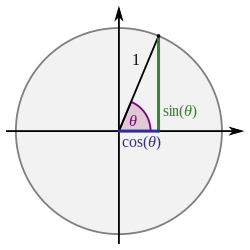 |
|
Reference |
|
Laws and theorems |
|
Calculus |
|
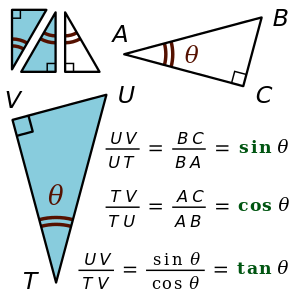
Basis of trigonometry: if two right triangles have equal acute angles, they are similar, so their side lengths are proportional. Proportionality constants are written within the image: sin θ, cos θ, tan θ, where θ is the common measure of five acute angles.
In mathematics, the trigonometric functions (also called circular functions, angle functions or goniometric functions[1][2]) are functions of an angle. They relate the angles of a triangle to the lengths of its sides. Trigonometric functions are important in the study of triangles and modeling periodic phenomena, among many other applications.
The most familiar trigonometric functions are the sine, cosine, and tangent. In the context of the standard unit circle (a circle with radius 1 unit), where a triangle is formed by a ray starting at the origin and making some angle with the x-axis, the sine of the angle gives the y-component (the opposite to the angle or the rise) of the triangle, the cosine gives the x-component (the adjacent of the angle or the run), and the tangent function gives the slope (y-component divided by the x-component). For angles less than a right angle, trigonometric functions are commonly defined as ratios of two sides of a right triangle containing the angle, and their values can be found in the lengths of various line segments around a unit circle. Modern definitions express trigonometric functions as infinite series or as solutions of certain differential equations, allowing the extension of the arguments to the whole number line and to the complex numbers.
Trigonometric functions have a wide range of uses including computing unknown lengths and angles in triangles (often right triangles). In this use, trigonometric functions are used, for instance, in navigation, engineering, and physics. A common use in elementary physics is resolving a vector into Cartesian coordinates. The sine and cosine functions are also commonly used to model periodic function phenomena such as sound and light waves, the position and velocity of harmonic oscillators, sunlight intensity and day length, and average temperature variations through the year.
In modern usage, there are six basic trigonometric functions, tabulated here with equations that relate them to one another. Especially with the last four, these relations are often taken as the definitions of those functions, but one can define them equally well geometrically, or by other means, and then derive these relations.
Contents
1 Right-angled triangle definitions
1.1 Sine, cosine, and tangent
1.2 Secant, cosecant, and cotangent
1.3 Mnemonics
2 Unit-circle definitions
3 Algebraic values
3.1 Explicit values
4 Series definitions
4.1 Relationship to exponential function and complex numbers
4.1.1 Complex graphs
5 Definitions via differential equations
5.1 The significance of radians
6 Identities
6.1 Calculus
6.2 Definitions using functional equations
7 Computation
7.1 Special values in trigonometric functions
8 Inverse functions
8.1 Connection to the inner product
9 Properties and applications
9.1 Law of sines
9.2 Law of cosines
9.3 Law of tangents
9.4 Law of cotangents
9.5 Periodic functions
10 History
11 Etymology
12 See also
13 Notes
14 References
15 External links
Right-angled triangle definitions
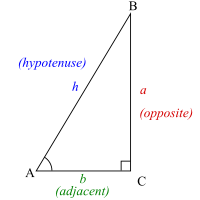

Top: Trigonometric function sin θ for selected angles θ, π − θ, π + θ, and 2π − θ in the four quadrants.
Bottom: Graph of sine function versus angle. Angles from the top panel are identified.

Plot of the six trigonometric functions and the unit circle for an angle of 0.7 radians.
The notion that there should be some standard correspondence between the lengths of the sides of a triangle and the angles of the triangle comes as soon as one recognizes that similar triangles maintain the same ratios between their sides. That is, for any similar triangle the ratio of the hypotenuse (for example) and another of the sides remains the same. If the hypotenuse is twice as long, so are the sides. It is these ratios that the trigonometric functions express.
To define the trigonometric functions for the angle A, start with any right triangle that contains the angle A. The three sides of the triangle are named as follows:
- The hypotenuse is the side opposite the right angle, in this case side h. The hypotenuse is always the longest side of a right-angled triangle.
- The opposite side is the side opposite to the angle we are interested in (angle A), in this case side a.
- The adjacent side is the side having both the angles of interest (angle A and right-angle C), in this case side b.
In ordinary Euclidean geometry, according to the triangle postulate, the inside angles of every triangle total 180° (π radians). Therefore, in a right-angled triangle, the two non-right angles total 90° (π/2 radians), so each of these angles must be in the range of (0, π/2) as expressed in interval notation. The following definitions apply to angles in this (0, π/2) range. They can be extended to the full set of real arguments by using the unit circle, or by requiring certain symmetries and that they be periodic functions. For example, the figure shows sin(θ) for angles θ, π − θ, π + θ, and 2π − θ depicted on the unit circle (top) and as a graph (bottom). The value of the sine repeats itself apart from sign in all four quadrants, and if the range of θ is extended to additional rotations, this behavior repeats periodically with a period 2π.
The trigonometric functions are summarized in the following table and described in more detail below. The angle θ is the angle between the hypotenuse and the adjacent line – the angle at A in the accompanying diagram.
| Function | Abbreviation | Description | Identities (using radians) |
|---|---|---|---|
| sine | sin | opposite/hypotenuse | sinθ=cos(π2−θ)=1cscθ{displaystyle sin theta =cos left({frac {pi }{2}}-theta right)={frac {1}{csc theta }}}  |
| cosine | cos | adjacent/hypotenuse | cosθ=sin(π2−θ)=1secθ{displaystyle cos theta =sin left({frac {pi }{2}}-theta right)={frac {1}{sec theta }},}  |
| tangent | tan (or tg) | opposite/adjacent | tanθ=sinθcosθ=cot(π2−θ)=1cotθ{displaystyle tan theta ={frac {sin theta }{cos theta }}=cot left({frac {pi }{2}}-theta right)={frac {1}{cot theta }}}  |
| cotangent | cot (or cotan or cotg or ctg or ctn) | adjacent/opposite | cotθ=cosθsinθ=tan(π2−θ)=1tanθ{displaystyle cot theta ={frac {cos theta }{sin theta }}=tan left({frac {pi }{2}}-theta right)={frac {1}{tan theta }}}  |
| secant | sec | hypotenuse/adjacent | secθ=csc(π2−θ)=1cosθ{displaystyle sec theta =csc left({frac {pi }{2}}-theta right)={frac {1}{cos theta }}}  |
| cosecant | csc (or cosec) | hypotenuse/opposite | cscθ=sec(π2−θ)=1sinθ{displaystyle csc theta =sec left({frac {pi }{2}}-theta right)={frac {1}{sin theta }}}  |
Sine, cosine, and tangent
The sine of an angle is the ratio of the length of the opposite side to the length of the hypotenuse. The word comes from the Latin sinus for gulf or bay,[3] since, given a unit circle, it is the side of the triangle on which the angle opens. In our case:
- sinA=oppositehypotenuse{displaystyle sin A={frac {textrm {opposite}}{textrm {hypotenuse}}}}

An illustration of the relationship between sine and its out-of-phase complement, cosine. Cosine is identical, but π/2 radians out of phase to the left; so cos A = sin(A + π/2).
The cosine (sine complement, Latin: cosinus, sinus complementi) of an angle is the ratio of the length of the adjacent side to the length of the hypotenuse, so called because it is the sine of the complementary or co-angle, the other non-right angle.[4] Because the angle sum of a triangle is π radians, the co-angle B is equal to π/2 − A; so cos A = sin B = sin(π/2 − A). In our case:
- cosA=adjacenthypotenuse{displaystyle cos A={frac {textrm {adjacent}}{textrm {hypotenuse}}}}
The tangent of an angle is the ratio of the length of the opposite side to the length of the adjacent side, so called because it can be represented as a line segment tangent to the circle, i.e. the line that touches the circle, from Latin linea tangens or touching line (cf. tangere, to touch).[5] In our case:
- tanA=oppositeadjacent{displaystyle tan A={frac {textrm {opposite}}{textrm {adjacent}}}}
Tangent may also be represented in terms of sine and cosine. That is:
- tanA=sinAcosA=oppositehypotenuseadjacenthypotenuse=oppositeadjacent{displaystyle tan A={frac {sin A}{cos A}}={frac {frac {textrm {opposite}}{textrm {hypotenuse}}}{frac {textrm {adjacent}}{textrm {hypotenuse}}}}={frac {textrm {opposite}}{textrm {adjacent}}}}
These ratios do not depend on the size of the particular right triangle chosen, as long as the focus angle is equal, since all such triangles are similar.
The acronyms "SOH-CAH-TOA" ("soak-a-toe", "sock-a-toa", "so-kah-toa") and "OHSAHCOAT" are commonly used trigonometric mnemonics for these ratios.
Secant, cosecant, and cotangent
The remaining three functions are best defined using the three functions above and can be considered their reciprocals.
The secant of an angle is the reciprocal of its cosine, that is, the ratio of the length of the hypotenuse to the length of the adjacent side, so called because it represents the secant line that cuts the circle (from Latin: secare, to cut):[6]
- secA=1cosA=hypotenuseadjacent=hb.{displaystyle sec A={frac {1}{cos A}}={frac {textrm {hypotenuse}}{textrm {adjacent}}}={frac {h}{b}}.}
The cosecant (secant complement, Latin: cosecans, secans complementi) of an angle is the reciprocal of its sine, that is, the ratio of the length of the hypotenuse to the length of the opposite side, so called because it is the secant of the complementary or co-angle:
- cscA=1sinA=hypotenuseopposite=ha.{displaystyle csc A={frac {1}{sin A}}={frac {textrm {hypotenuse}}{textrm {opposite}}}={frac {h}{a}}.}
The cotangent (tangent complement, Latin: cotangens, tangens complementi) of an angle is the reciprocal of its tangent, that is, the ratio of the length of the adjacent side to the length of the opposite side, so called because it is the tangent of the complementary or co-angle:
- cotA=1tanA=adjacentopposite=ba.{displaystyle cot A={frac {1}{tan A}}={frac {textrm {adjacent}}{textrm {opposite}}}={frac {b}{a}}.}
Mnemonics
Equivalent to the right-triangle definitions, the trigonometric functions can also be defined in terms of the rise, run, and slope of a line segment relative to horizontal. The slope is commonly taught as "rise over run" or rise/run. The three main trigonometric functions are commonly taught in the order sine, cosine and tangent. With a line segment length of 1 (as in a unit circle), the following mnemonic devices show the correspondence of definitions:
- "Sine is first, rise is first" meaning that Sine takes the angle of the line segment and tells its vertical rise when the length of the line is 1.
- "Cosine is second, run is second" meaning that Cosine takes the angle of the line segment and tells its horizontal run when the length of the line is 1.
- "Tangent combines the rise and run" meaning that Tangent takes the angle of the line segment and tells its slope, or alternatively, tells the vertical rise when the line segment's horizontal run is 1.
This shows the main use of tangent and arctangent: converting between the two ways of telling the slant of a line, i.e. angles and slopes. (The arctangent or "inverse tangent" is not to be confused with the cotangent, which is cosine divided by sine.)
While the length of the line segment makes no difference for the slope (the slope does not depend on the length of the slanted line), it does affect rise and run. To adjust and find the actual rise and run when the line does not have a length of 1, just multiply the sine and cosine by the line length. For instance, if the line segment has length 5, the run at an angle of 7° is 5cos(7°).
Unit-circle definitions

In this illustration, the six trigonometric functions of an arbitrary angle θ are represented as Cartesian coordinates of points related to the unit circle. The ordinates of A, B and D are sin θ, tan θ and csc θ, respectively, while the abscissas of A, C and E are cos θ, cot θ and sec θ, respectively.

Signs of trigonometric functions in each quadrant. The mnemonic "all science teachers (are) crazy" lists the functions which are positive from quadrants I to IV.[7] This is a variation on the mnemonic "All Students Take Calculus".
The six trigonometric functions can be defined as coordinate values of points on the Euclidean plane that are related to the unit circle, which is the circle of radius one centered at the origin O of this coordinate system. While right-angled triangle definitions permit the definition of the trigonometric functions for angles between 0 and π2{displaystyle {tfrac {pi }{2}}}
Rotating a ray from the direction of the positive half of the x-axis by an angle θ (counterclockwise for θ>0,{displaystyle theta >0,}






The trigonometric functions cos and sin are defined, respectively, as the x- and y-coordinate values of point A, i.e.,
cos(θ)=xA{displaystyle cos(theta )=x_{mathrm {A} }quad }and sin(θ)=yA.{displaystyle quad sin(theta )=y_{mathrm {A} }.}
[8]
In the range 0≤θ≤π/2{displaystyle 0leq theta leq pi /2}


- cos2θ+sin2θ=1.{displaystyle cos ^{2}theta +sin ^{2}theta =1.}
The other trigonometric functions can be found along the unit circle as
tan(θ)=yB{displaystyle tan(theta )=y_{mathrm {B} }quad }and cot(θ)=xC,{displaystyle quad cot(theta )=x_{mathrm {C} },}
csc(θ) =yD{displaystyle csc(theta ) =y_{mathrm {D} }quad }and sec(θ)=xE.{displaystyle quad sec(theta )=x_{mathrm {E} }.}
By applying the Pythagorean identity and geometric proof methods, these definitions can readily be shown to coincide with the definitions of tangent, cotangent, secant and cosecant in terms of sine and cosine, that is
- tanθ=sinθcosθ,cotθ=cosθsinθ,secθ=1cosθ,cscθ=1sinθ.{displaystyle tan theta ={frac {sin theta }{cos theta }},quad cot theta ={frac {cos theta }{sin theta }},quad sec theta ={frac {1}{cos theta }},quad csc theta ={frac {1}{sin theta }}.}

Trigonometric functions: Sine, Cosine, Tangent, Cosecant (dotted), Secant (dotted), Cotangent (dotted)
As a rotation of an angle of ±2π{displaystyle pm 2pi }


sinθ=sin(θ+2kπ){displaystyle sin theta =sin left(theta +2kpi right)quad }and cosθ=cos(θ+2kπ){displaystyle quad cos theta =cos left(theta +2kpi right)}
hold for any angle θ and any integer k. The same is true for the four other trigonometric functions. Observing the sign and the monotonicity of the functions sine, cosine, cosecant, and secant in the four quadrants, shows that 2π is the smallest value for which they are periodic, i.e., 2π is the fundamental period of these functions. However, already after a rotation by an angle π{displaystyle pi }
tanθ=tan(θ+kπ){displaystyle tan theta =tan(theta +kpi )quad }and cotθ=cot(θ+kπ){displaystyle quad cot theta =cot(theta +kpi )}
hold for any angle θ and any integer k.
Algebraic values
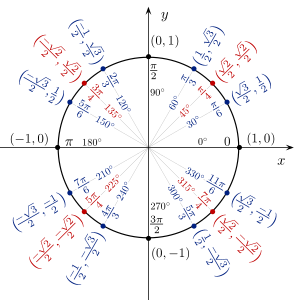
The unit circle, with some points labeled with their cosine and sine (in this order), and the corresponding angles in radians and degrees.
The algebraic expressions for sin(0°), sin(30°), sin(45°), sin(60°) and sin(90°) are
- 0,12,22,32,1,{displaystyle 0,quad {frac {1}{2}},quad {frac {sqrt {2}}{2}},quad {frac {sqrt {3}}{2}},quad 1,,!}
respectively. Writing the numerators as square roots of consecutive natural numbers (02,12,22,32,42{displaystyle {tfrac {sqrt {0}}{2}},{tfrac {sqrt {1}}{2}},{tfrac {sqrt {2}}{2}},{tfrac {sqrt {3}}{2}},{tfrac {sqrt {4}}{2}}}
Such simple expressions generally do not exist for other angles which are rational multiples of a straight angle.
For an angle which, measured in degrees, is a multiple of three, the sine and the cosine may be expressed in terms of square roots, as shown below. These values of the sine and the cosine may thus be constructed by ruler and compass.
For an angle of an integer number of degrees, the sine and the cosine may be expressed in terms of square roots and the cube root of a non-real complex number. Galois theory allows proof that, if the angle is not a multiple of 3°, non-real cube roots are unavoidable.
For an angle which, measured in degrees, is a rational number, the sine and the cosine are algebraic numbers, which may be expressed in terms of nth roots. This results from the fact that the Galois groups of the cyclotomic polynomials are cyclic.
For an angle which, measured in degrees, is not a rational number, then either the angle or both the sine and the cosine are transcendental numbers. This is a corollary of Baker's theorem, proved in 1966.
Explicit values
Algebraic expressions for 15°, 18°, 36°, 54°, 72° and 75° are as follows:
- sin15∘=cos75∘=6−24{displaystyle sin 15^{circ }=cos 75^{circ }={frac {{sqrt {6}}-{sqrt {2}}}{4}},!}
- sin18∘=cos72∘=5−14{displaystyle sin 18^{circ }=cos 72^{circ }={frac {{sqrt {5}}-1}{4}}}
- sin36∘=cos54∘=10−254{displaystyle sin 36^{circ }=cos 54^{circ }={frac {sqrt {10-2{sqrt {5}}}}{4}}}
- sin54∘=cos36∘=5+14{displaystyle sin 54^{circ }=cos 36^{circ }={frac {{sqrt {5}}+1}{4}},!}
- sin72∘=cos18∘=10+254{displaystyle sin 72^{circ }=cos 18^{circ }={frac {sqrt {10+2{sqrt {5}}}}{4}}}
- sin75∘=cos15∘=6+24.{displaystyle sin 75^{circ }=cos 15^{circ }={frac {{sqrt {6}}+{sqrt {2}}}{4}}.,}
From these, the algebraic expressions for all multiples of 3° can be computed. For example:
- sin3∘=cos87∘=2(1−3)5+5+(1+3)(10−2)16{displaystyle sin 3^{circ }=cos 87^{circ }={frac {2left(1-{sqrt {3}}right){sqrt {5+{sqrt {5}}}}+left(1+{sqrt {3}}right)left({sqrt {10}}-{sqrt {2}}right)}{16}},!}
- sin6∘=cos84∘=30−65−5−18{displaystyle sin 6^{circ }=cos 84^{circ }={frac {{sqrt {30-6{sqrt {5}}}}-{sqrt {5}}-1}{8}},!}
- sin9∘=cos81∘=10+2−25−58{displaystyle sin 9^{circ }=cos 81^{circ }={frac {{sqrt {10}}+{sqrt {2}}-2{sqrt {5-{sqrt {5}}}}}{8}},!}
- sin84∘=cos6∘=10−25+3+158{displaystyle sin 84^{circ }=cos 6^{circ }={frac {{sqrt {10-2{sqrt {5}}}}+{sqrt {3}}+{sqrt {15}}}{8}}}
- sin87∘=cos3∘=2(1+3)5+5−(1−3)(10−2)16.{displaystyle sin 87^{circ }=cos 3^{circ }={frac {2left(1+{sqrt {3}}right){sqrt {5+{sqrt {5}}}}-left(1-{sqrt {3}}right)left({sqrt {10}}-{sqrt {2}}right)}{16}}.}
Algebraic expressions can be deduced for other angles of an integer number of degrees, for example,
- sin1∘=z3−1z32i,{displaystyle sin 1^{circ }={frac {{sqrt[{3}]{z}}-{dfrac {1}{sqrt[{3}]{z}}}}{2i}},}
where z = a + ib, and a and b are the above algebraic expressions for, respectively, cos 3° and sin 3°, and the principal cube root (that is, the cube root with the largest real part) is to be taken.
Series definitions

The sine function (blue) is closely approximated by its Taylor polynomial of degree 7 (pink) for a full cycle centered on the origin.
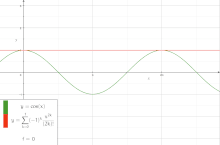
Animation for the approximation of cosine via Taylor polynomials.
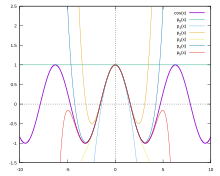
cos(x){displaystyle cos(x)}
 together with the first Taylor polynomials pn(x)=∑k=0n(−1)kx2k(2k)!{displaystyle p_{n}(x)=sum _{k=0}^{n}(-1)^{k}{frac {x^{2k}}{(2k)!}}}
together with the first Taylor polynomials pn(x)=∑k=0n(−1)kx2k(2k)!{displaystyle p_{n}(x)=sum _{k=0}^{n}(-1)^{k}{frac {x^{2k}}{(2k)!}}}
Trigonometric functions are analytic functions. Using only geometry and properties of limits, it can be shown that the derivative of sine is cosine and the derivative of cosine is the negative of sine. One can then use the theory of Taylor series to show that the following identities hold for all real numbers x.[10] Here, and generally in calculus, all angles are measured in radians.
- sinx=x−x33!+x55!−x77!+⋯=∑n=0∞(−1)nx2n+1(2n+1)!{displaystyle {begin{aligned}sin x&=x-{frac {x^{3}}{3!}}+{frac {x^{5}}{5!}}-{frac {x^{7}}{7!}}+cdots \&=sum _{n=0}^{infty }{frac {(-1)^{n}x^{2n+1}}{(2n+1)!}}\end{aligned}}}
- cosx=1−x22!+x44!−x66!+⋯=∑n=0∞(−1)nx2n(2n)!{displaystyle {begin{aligned}cos x&=1-{frac {x^{2}}{2!}}+{frac {x^{4}}{4!}}-{frac {x^{6}}{6!}}+cdots \&=sum _{n=0}^{infty }{frac {(-1)^{n}x^{2n}}{(2n)!}}end{aligned}}}
The infinite series appearing in these identities are convergent in the whole complex plane and are often taken as the definitions of the sine and cosine functions of a complex variable. Another standard (and equivalent) definition of the sine and the cosine as functions of a complex variable is through their differential equation, below.
Other series can be found.[11] For the following trigonometric functions:
Un is the nth up/down number,
Bn is the nth Bernoulli number, and
En (below) is the nth Euler number.
- tanx=∑n=0∞U2n+1x2n+1(2n+1)!=∑n=1∞(−1)n−122n(22n−1)B2nx2n−1(2n)!=x+13x3+215x5+17315x7+⋯,for |x|<π2.{displaystyle {begin{aligned}tan x&{}=sum _{n=0}^{infty }{frac {U_{2n+1}x^{2n+1}}{(2n+1)!}}\&{}=sum _{n=1}^{infty }{frac {(-1)^{n-1}2^{2n}left(2^{2n}-1right)B_{2n}x^{2n-1}}{(2n)!}}\&{}=x+{frac {1}{3}}x^{3}+{frac {2}{15}}x^{5}+{frac {17}{315}}x^{7}+cdots ,qquad {text{for }}|x|<{frac {pi }{2}}.end{aligned}}}
- cscx=∑n=0∞(−1)n+12(22n−1−1)B2nx2n−1(2n)!=x−1+16x+7360x3+3115120x5+⋯,for 0<|x|<π.{displaystyle {begin{aligned}csc x&{}=sum _{n=0}^{infty }{frac {(-1)^{n+1}2left(2^{2n-1}-1right)B_{2n}x^{2n-1}}{(2n)!}}\&{}=x^{-1}+{frac {1}{6}}x+{frac {7}{360}}x^{3}+{frac {31}{15120}}x^{5}+cdots ,qquad {text{for }}0<|x|<pi .end{aligned}}}
- secx=∑n=0∞U2nx2n(2n)!=∑n=0∞(−1)nE2nx2n(2n)!=1+12x2+524x4+61720x6+⋯,for |x|<π2.{displaystyle {begin{aligned}sec x&{}=sum _{n=0}^{infty }{frac {U_{2n}x^{2n}}{(2n)!}}=sum _{n=0}^{infty }{frac {(-1)^{n}E_{2n}x^{2n}}{(2n)!}}\&{}=1+{frac {1}{2}}x^{2}+{frac {5}{24}}x^{4}+{frac {61}{720}}x^{6}+cdots ,qquad {text{for }}|x|<{frac {pi }{2}}.end{aligned}}}
- cotx=∑n=0∞(−1)n22nB2nx2n−1(2n)!=x−1−13x−145x3−2945x5−⋯,for 0<|x|<π.{displaystyle {begin{aligned}cot x&{}=sum _{n=0}^{infty }{frac {(-1)^{n}2^{2n}B_{2n}x^{2n-1}}{(2n)!}}\&{}=x^{-1}-{frac {1}{3}}x-{frac {1}{45}}x^{3}-{frac {2}{945}}x^{5}-cdots ,qquad {text{for }}0<|x|<pi .end{aligned}}}
When the series for the tangent and secant functions are expressed in a form in which the denominators are the corresponding factorials, the numerators, called the "tangent numbers" and "secant numbers" respectively, have a combinatorial interpretation: they enumerate alternating permutations of finite sets, of odd cardinality for the tangent series and even cardinality for the secant series.[12] The series itself can be found by a power series solution of the aforementioned differential equation.
From a theorem in complex analysis, there is a unique analytic continuation of this real function to the domain of complex numbers. They have the same Taylor series, and so the trigonometric functions are defined on the complex numbers using the Taylor series above.
There is a series representation as partial fraction expansion where just translated reciprocal functions are summed up, such that the poles of the cotangent function and the reciprocal functions match:[13]
- π⋅cot(πx)=limN→∞∑n=−NN1x+n.{displaystyle pi cdot cot(pi x)=lim _{Nto infty }sum _{n=-N}^{N}{frac {1}{x+n}}.}
This identity can be proven with the Herglotz trick.[14]
Combining the (–n)th with the nth term lead to absolutely convergent series:
- π⋅cot(πx)=1x+2x∑n=1∞1x2−n2 ,πsin(πx)=1x+2x∑n=1∞(−1)nx2−n2.{displaystyle pi cdot cot(pi x)={frac {1}{x}}+2xsum _{n=1}^{infty }{frac {1}{x^{2}-n^{2}}} ,quad {frac {pi }{sin(pi x)}}={frac {1}{x}}+2xsum _{n=1}^{infty }{frac {(-1)^{n}}{x^{2}-n^{2}}}.}
Relationship to exponential function and complex numbers

Euler's formula illustrated with the three dimensional helix, starting with the 2D orthogonal components of the unit circle, sine and cosine (using θ = t).

cos(θ){displaystyle cos(theta )}
 and sin(θ){displaystyle sin(theta )}
and sin(θ){displaystyle sin(theta )} are the real and imaginary part of eiθ{displaystyle e^{itheta }}
are the real and imaginary part of eiθ{displaystyle e^{itheta }} respectively.
respectively.It can be shown from the series definitions[15] that the sine and cosine functions are respectively the imaginary and real parts of the exponential function of a purely imaginary argument. That is, if x is real, we have
- cosx=Re(eix),sinx=Im(eix),{displaystyle cos x=operatorname {Re} left(e^{ix}right),,qquad sin x=operatorname {Im} left(e^{ix}right),,}
and
- eix=cosx+isinx.{displaystyle e^{ix}=cos x+isin x,.}
The latter identity, although primarily established for real x, remains valid for every complex x, and is called Euler's formula.
Euler's formula can be used to derive most trigonometric identities from the properties of the exponential function, by writing sine and cosine as:
- sinx=eix−e−ix2i,{displaystyle sin x={frac {e^{ix}-e^{-ix}}{2i}},}
and
- cosx=eix+e−ix2.{displaystyle cos x={frac {e^{ix}+e^{-ix}}{2}},.}
It is also sometimes useful to express the complex sine and cosine functions in terms of the real and imaginary parts of their arguments.
- sin(x+iy)=sinxcoshy+icosxsinhy,cos(x+iy)=cosxcoshy−isinxsinhy.{displaystyle {begin{aligned}sin(x+iy)&=sin xcosh y+icos xsinh y,,\cos(x+iy)&=cos xcosh y-isin xsinh y,.end{aligned}}}
This exhibits a deep relationship between the complex sine and cosine functions and their real (sin, cos) and hyperbolic real (sinh, cosh) counterparts.
Complex graphs
In the following graphs the domain is the complex plane pictured with domain coloring, and the range values are indicated at each point by color. Brightness indicates the size (absolute value) of the range value, with black being zero. Hue varies with argument, or angle, measured from the positive real axis.
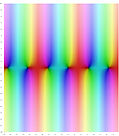 | 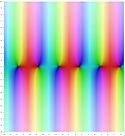 |  | 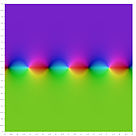 |  |  |
sinz{displaystyle sin z,}  | cosz{displaystyle cos z,}  | tanz{displaystyle tan z,}  | cotz{displaystyle cot z,}  | secz{displaystyle sec z,}  | cscz{displaystyle csc z,}  |
Definitions via differential equations
Both the sine and cosine functions satisfy the linear differential equation:
- y″=−y.{displaystyle y''=-y,.}
That is to say, each is the additive inverse of its own second derivative. Within the 2-dimensional function space V consisting of all solutions of this equation,
- the sine function is the unique solution satisfying the initial condition (y′(0),y(0))=(1,0){displaystyle left(y'(0),y(0)right)=(1,0),}
and
- the cosine function is the unique solution satisfying the initial condition (y′(0),y(0))=(0,1){displaystyle left(y'(0),y(0)right)=(0,1),}
.
Since the sine and cosine functions are linearly independent, together they form a basis of V. This method of defining the sine and cosine functions is essentially equivalent to using Euler's formula. (See linear differential equation.) It turns out that this differential equation can be used not only to define the sine and cosine functions but also to prove the trigonometric identities for the sine and cosine functions.
Further, the observation that sine and cosine satisfies y″ = −y means that they are eigenfunctions of the second-derivative operator.
The tangent function is the unique solution of the nonlinear differential equation
- y′=1+y2{displaystyle y'=1+y^{2},}
satisfying the initial condition y(0) = 0. There is a very interesting visual proof that the tangent function satisfies this differential equation.[16]
The significance of radians
Radians specify an angle by measuring the length around the path of the unit circle and constitute a special argument to the sine and cosine functions. In particular, only sines and cosines that map radians to ratios satisfy the differential equations that classically describe them. If an argument to sine or cosine in radians is scaled by frequency,
- f(x)=sin(kx),{displaystyle f(x)=sin(kx),,}
then the derivatives will scale by amplitude.
- f′(x)=kcos(kx).{displaystyle f'(x)=kcos(kx).,}
Here, k is a constant that represents a mapping between units. If x is in degrees, then
- k=π180∘.{displaystyle k={frac {pi }{180^{circ }}}.}
This means that the second derivative of a sine in degrees does not satisfy the differential equation
- y″=−y{displaystyle y''=-y,}
but rather
- y″=−k2y.{displaystyle y''=-k^{2}y.,}
The cosine's second derivative behaves similarly.
This means that these sines and cosines are different functions, and that the fourth derivative of sine will be sine again only if the argument is in radians.
Identities
Many identities interrelate the trigonometric functions. Among the most frequently used is the Pythagorean identity, which states that for any angle, the square of the sine plus the square of the cosine is 1. This is easy to see by studying a right triangle of hypotenuse 1 and applying the Pythagorean theorem. In symbolic form, the Pythagorean identity is written
- sin2x+cos2x=1{displaystyle sin ^{2}x+cos ^{2}x=1}
which is standard shorthand notation for
- (sinx)2+(cosx)2=1.{displaystyle (sin x)^{2}+(cos x)^{2}=1.}
Other key relationships are the sum and difference formulas, which give the sine and cosine of the sum and difference of two angles in terms of sines and cosines of the angles themselves. These can be derived geometrically, using arguments that date to Ptolemy. One can also produce them algebraically using Euler's formula.
- Sum
- sin(x+y)=sinxcosy+cosxsiny,cos(x+y)=cosxcosy−sinxsiny,{displaystyle {begin{aligned}sin left(x+yright)&=sin xcos y+cos xsin y,\cos left(x+yright)&=cos xcos y-sin xsin y,end{aligned}}}
- Difference
- sin(x−y)=sinxcosy−cosxsiny,cos(x−y)=cosxcosy+sinxsiny.{displaystyle {begin{aligned}sin left(x-yright)&=sin xcos y-cos xsin y,\cos left(x-yright)&=cos xcos y+sin xsin y.end{aligned}}}
These in turn lead to the following three-angle formulae:
- sin(x+y+z)=sinxcosycosz+sinycoszcosx+sinzcosycosx−sinxsinysinz,cos(x+y+z)=cosxcosycosz−cosxsinysinz−cosysinxsinz−coszsinxsiny,{displaystyle {begin{aligned}sin left(x+y+zright)&=sin xcos ycos z+sin ycos zcos x+sin zcos ycos x-sin xsin ysin z,\cos left(x+y+zright)&=cos xcos ycos z-cos xsin ysin z-cos ysin xsin z-cos zsin xsin y,end{aligned}}}
When the two angles are equal, the sum formulas reduce to simpler equations known as the double-angle formulae.
- sin(2x)=2sinxcosx,cos(2x)=cos2x−sin2x=2cos2x−1=1−2sin2x.{displaystyle {begin{aligned}sin left(2xright)&=2sin xcos x,\cos left(2xright)&=cos ^{2}x-sin ^{2}x=2cos ^{2}x-1=1-2sin ^{2}x.end{aligned}}}
When three angles are equal, the three-angle formulae simplify to
- sin(3x)=3sinx−4sin3x.cos(3x)=4cos3x−3cosx.{displaystyle {begin{aligned}sin(3x)&=3sin x-4sin ^{3}x.\cos(3x)&=4cos ^{3}x-3cos x.end{aligned}}}
These identities can also be used to derive the product-to-sum identities that were used in antiquity to transform the product of two numbers into a sum of numbers and greatly speed operations, much like the logarithm function.
Calculus
For integrals and derivatives of trigonometric functions, see the relevant sections of Differentiation of trigonometric functions, Lists of integrals and List of integrals of trigonometric functions. Below is the list of the derivatives and integrals of the six basic trigonometric functions. The number C is a constant of integration.
- f(x)f′(x)∫f(x)dxsinxcosx−cosx+Ccosx−sinxsinx+Ctanxsec2x=1+tan2x−ln|cosx|+Ccotx−csc2x=−(1+cot2x)ln|sinx|+Csecxsecxtanxln|secx+tanx|+Ccscx−cscxcotx−ln|cscx+cotx|+C{displaystyle {begin{array}{|r|rr|}f(x)&f'(x)&int f(x),dx\hline sin x&cos x&-cos x+C\cos x&-sin x&sin x+C\tan x&sec ^{2}x=1+tan ^{2}x&-ln left|cos xright|+C\cot x&-csc ^{2}x=-(1+cot ^{2}x)&ln left|sin xright|+C\sec x&sec xtan x&ln left|sec x+tan xright|+C\csc x&-csc xcot x&-ln left|csc x+cot xright|+Cend{array}}}
Definitions using functional equations
In mathematical analysis, one can define the trigonometric functions using functional equations based on properties like the difference formula. Taking as given these formulas, one can prove that only two continuous functions satisfy those conditions. Formally, there exists exactly one pair of continuous functions—sin and cos—such that for all real numbers x and y, the following equation holds:[17]
- cos(x−y)=cosxcosy+sinxsiny{displaystyle cos(x-y)=cos xcos y+sin xsin y,}
with the added condition that
- 0<xcosx<sinx<x for 0<x<1.{displaystyle 0<xcos x<sin x<xquad {text{ for }}quad 0<x<1.,}
This may also be used for extending sine and cosine to the complex numbers. Other functional equations are also possible for defining trigonometric functions.
Computation
The computation of trigonometric functions is a complicated subject, which can today be avoided by most people because of the widespread availability of computers and scientific calculators that provide built-in trigonometric functions for any angle. This section, however, describes details of their computation in three important contexts: the historical use of trigonometric tables, the modern techniques used by computers, and a few "important" angles where simple exact values are easily found.
The first step in computing any trigonometric function is range reduction—reducing the given angle to a "reduced angle" inside a small range of angles, say 0 to π/2, using the periodicity and symmetries of the trigonometric functions.
Prior to computers, people typically evaluated trigonometric functions by interpolating from a detailed table of their values, calculated to many significant figures. Such tables have been available for as long as trigonometric functions have been described (see History below), and were typically generated by repeated application of the half-angle and angle-addition identities starting from a known value (such as sin(π/2) = 1).
Modern computers use a variety of techniques.[18] One common method, especially on higher-end processors with floating point units, is to combine a polynomial or rational approximation (such as Chebyshev approximation, best uniform approximation, and Padé approximation, and typically for higher or variable precisions, Taylor and Laurent series) with range reduction and a table lookup—they first look up the closest angle in a small table, and then use the polynomial to compute the correction.[19] Devices that lack hardware multipliers often use an algorithm called CORDIC (as well as related techniques), which uses only addition, subtraction, bitshift, and table lookup. These methods are commonly implemented in hardware floating-point units for performance reasons.
For very high precision calculations, when series expansion convergence becomes too slow, trigonometric functions can be approximated by the arithmetic-geometric mean, which itself approximates the trigonometric function by the (complex) elliptic integral.[20]
Finally, for some simple angles, the values can be easily computed by hand using the Pythagorean theorem, as in the following examples. For example, the sine, cosine and tangent of any integer multiple of π/60 radians (3°) can be found exactly by hand.
Consider a right triangle where the two other angles are equal, and therefore are both π/4 radians (45°). Then the length of side b and the length of side a are equal; we can choose a = b = 1. The values of sine, cosine and tangent of an angle of π/4 radians (45°) can then be found using the Pythagorean theorem:
- c=a2+b2=2.{displaystyle c={sqrt {a^{2}+b^{2}}}={sqrt {2}},.}
Therefore:
- sinπ4=sin45∘=cosπ4=cos45∘=12=22,{displaystyle sin {frac {pi }{4}}=sin 45^{circ }=cos {frac {pi }{4}}=cos 45^{circ }={1 over {sqrt {2}}}={{sqrt {2}} over 2},,}
- tanπ4=tan45∘=sinπ4cosπ4=12⋅21=22=1.{displaystyle tan {frac {pi }{4}}=tan 45^{circ }={{sin {frac {pi }{4}}} over {cos {frac {pi }{4}}}}={1 over {sqrt {2}}}cdot {{sqrt {2}} over 1}={{sqrt {2}} over {sqrt {2}}}=1.,}

Computing trigonometric functions from an equilateral triangle
To determine the trigonometric functions for angles of π/3 radians (60°) and π/6 radians (30°), we start with an equilateral triangle of side length 1. All its angles are π/3 radians (60°). By dividing it into two, we obtain a right triangle with π/6 radians (30°) and π/3 radians (60°) angles. For this triangle, the shortest side is 1/2, the next largest side is √3/2 and the hypotenuse is 1. This yields:
- sinπ6=sin30∘=cosπ3=cos60∘=12,{displaystyle sin {frac {pi }{6}}=sin 30^{circ }=cos {frac {pi }{3}}=cos 60^{circ }={1 over 2},,}
- cosπ6=cos30∘=sinπ3=sin60∘=32,{displaystyle cos {frac {pi }{6}}=cos 30^{circ }=sin {frac {pi }{3}}=sin 60^{circ }={{sqrt {3}} over 2},,}
- tanπ6=tan30∘=cotπ3=cot60∘=13=33.{displaystyle tan {frac {pi }{6}}=tan 30^{circ }=cot {frac {pi }{3}}=cot 60^{circ }={1 over {sqrt {3}}}={{sqrt {3}} over 3},.}
Special values in trigonometric functions
There are some commonly used special values in trigonometric functions, as shown in the following table.
RadianDegree00∘π1215∘π822.5∘π630∘π445∘π360∘5π1275∘π290∘sin06−242−221222326+241cos16+242+223222126−240tan02−32−133132+3∞cot∞2+32+131332−30sec16−222−2233226+2∞csc∞6+222+2222336−21{displaystyle {begin{array}{|c|cccccccc|}{begin{matrix}{text{Radian}}\{text{Degree}}end{matrix}}&{begin{matrix}0\0^{circ }end{matrix}}&{begin{matrix}{frac {pi }{12}}\15^{circ }end{matrix}}&{begin{matrix}{frac {pi }{8}}\22.5^{circ }end{matrix}}&{begin{matrix}{frac {pi }{6}}\30^{circ }end{matrix}}&{begin{matrix}{frac {pi }{4}}\45^{circ }end{matrix}}&{begin{matrix}{frac {pi }{3}}\60^{circ }end{matrix}}&{begin{matrix}{frac {5pi }{12}}\75^{circ }end{matrix}}&{begin{matrix}{frac {pi }{2}}\90^{circ }end{matrix}}\hline sin &0&{frac {{sqrt {6}}-{sqrt {2}}}{4}}&{frac {sqrt {2-{sqrt {2}}}}{2}}&{frac {1}{2}}&{frac {sqrt {2}}{2}}&{frac {sqrt {3}}{2}}&{frac {{sqrt {6}}+{sqrt {2}}}{4}}&1\cos &1&{frac {{sqrt {6}}+{sqrt {2}}}{4}}&{frac {sqrt {2+{sqrt {2}}}}{2}}&{frac {sqrt {3}}{2}}&{frac {sqrt {2}}{2}}&{frac {1}{2}}&{frac {{sqrt {6}}-{sqrt {2}}}{4}}&0\tan &0&2-{sqrt {3}}&{sqrt {2}}-1&{frac {sqrt {3}}{3}}&1&{sqrt {3}}&2+{sqrt {3}}&infty \cot &infty &2+{sqrt {3}}&{sqrt {2}}+1&{sqrt {3}}&1&{frac {sqrt {3}}{3}}&2-{sqrt {3}}&0\sec &1&{sqrt {6}}-{sqrt {2}}&{sqrt {2}}{sqrt {2-{sqrt {2}}}}&{frac {2{sqrt {3}}}{3}}&{sqrt {2}}&2&{sqrt {6}}+{sqrt {2}}&infty \csc &infty &{sqrt {6}}+{sqrt {2}}&{sqrt {2}}{sqrt {2+{sqrt {2}}}}&2&{sqrt {2}}&{frac {2{sqrt {3}}}{3}}&{sqrt {6}}-{sqrt {2}}&1\end{array}}}[21]
The symbol ∞ here represents the point at infinity on the projectively extended real line, the limit on the extended real line is +∞ on one side and -∞ on the other.
Inverse functions
The trigonometric functions are periodic, and hence not injective, so strictly they do not have an inverse function. Therefore, to define an inverse function we must restrict their domains so that the trigonometric function is bijective. In the following, the functions on the left are defined by the equation on the right; these are not proved identities. The principal inverses are usually defined as:
- FunctionDefinitionValue Fieldarcsinx=ysiny=x−π2≤y≤π2arccosx=ycosy=x0≤y≤πarctanx=ytany=x−π2<y<π2arccotx=ycoty=x0<y<πarcsecx=ysecy=x0≤y≤π,y≠π2arccscx=ycscy=x−π2≤y≤π2,y≠0{displaystyle {begin{array}{rrc}{text{Function}}&{text{Definition}}&{text{Value Field}}\hline arcsin x=y&sin y=x&-{frac {pi }{2}}leq yleq {frac {pi }{2}}\arccos x=y&cos y=x&0leq yleq pi \arctan x=y&tan y=x&-{frac {pi }{2}}<y<{frac {pi }{2}}\operatorname {arccot} x=y&cot y=x&0<y<pi \operatorname {arcsec} x=y&sec y=x&0leq yleq pi ,,yneq {frac {pi }{2}}\operatorname {arccsc} x=y&csc y=x&-{frac {pi }{2}}leq yleq {frac {pi }{2}},,yneq 0end{array}}}
The notations sin−1 and cos−1 are often used for arcsin and arccos, etc. When this notation is used, the inverse functions could be confused with the multiplicative inverses of the functions. The notation using the "arc-" prefix avoids such confusion, though "arcsec" for arcsecant can be confused with "arcsecond".
Just like the sine and cosine, the inverse trigonometric functions can also be defined in terms of infinite series. For example,
- arcsinz=z+(12)z33+(1⋅32⋅4)z55+(1⋅3⋅52⋅4⋅6)z77+⋯.{displaystyle arcsin z=z+left({frac {1}{2}}right){frac {z^{3}}{3}}+left({frac {1cdot 3}{2cdot 4}}right){frac {z^{5}}{5}}+left({frac {1cdot 3cdot 5}{2cdot 4cdot 6}}right){frac {z^{7}}{7}}+cdots ,.}
These functions may also be defined by proving that they are antiderivatives of other functions. The arcsine, for example, can be written as the following integral:
- arcsinz=∫0z11−x2dx,|z|<1.{displaystyle arcsin z=int _{0}^{z}{frac {1}{sqrt {1-x^{2}}}},dx,quad |z|<1.}
Analogous formulas for the other functions can be found at inverse trigonometric functions. Using the complex logarithm, one can generalize all these functions to complex arguments:
- arcsinz=−ilog(iz+1−z2),arccosz=−ilog(z+z2−1),arctanz=12ilog(1−iz1+iz).{displaystyle {begin{aligned}arcsin z&=-ilog left(iz+{sqrt {1-z^{2}}}right),,\arccos z&=-ilog left(z+{sqrt {z^{2}-1}}right),,\arctan z&={frac {1}{2}}ilog left({frac {1-iz}{1+iz}}right).end{aligned}}}
Connection to the inner product
In an inner product space, the angle between two non-zero vectors is defined to be
- angle(x,y)=arccos⟨x,y⟩‖x‖⋅‖y‖.{displaystyle operatorname {angle} (x,y)=arccos {frac {langle x,yrangle }{|x|cdot |y|}}.}
Properties and applications
The trigonometric functions, as the name suggests, are of crucial importance in trigonometry, mainly because of the following two results.
Law of sines
The law of sines states that for an arbitrary triangle with sides a, b, and c and angles opposite those sides A, B and C:
- sinAa=sinBb=sinCc=2Δabc,{displaystyle {frac {sin A}{a}}={frac {sin B}{b}}={frac {sin C}{c}}={frac {2Delta }{abc}},}
where Δ is the area of the triangle,
or, equivalently,
- asinA=bsinB=csinC=2R,{displaystyle {frac {a}{sin A}}={frac {b}{sin B}}={frac {c}{sin C}}=2R,}
where R is the triangle's circumradius.
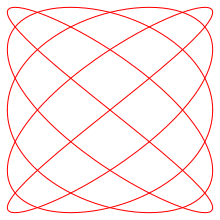
A Lissajous curve, a figure formed with a trigonometry-based function.
It can be proven by dividing the triangle into two right ones and using the above definition of sine. The law of sines is useful for computing the lengths of the unknown sides in a triangle if two angles and one side are known. This is a common situation occurring in triangulation, a technique to determine unknown distances by measuring two angles and an accessible enclosed distance.
Law of cosines
The law of cosines (also known as the cosine formula or cosine rule) is an extension of the Pythagorean theorem:
- c2=a2+b2−2abcosC,{displaystyle c^{2}=a^{2}+b^{2}-2abcos C,,}
or equivalently,
- cosC=a2+b2−c22ab.{displaystyle cos C={frac {a^{2}+b^{2}-c^{2}}{2ab}}.}
In this formula the angle at C is opposite to the side c. This theorem can be proven by dividing the triangle into two right ones and using the Pythagorean theorem.
The law of cosines can be used to determine a side of a triangle if two sides and the angle between them are known. It can also be used to find the cosines of an angle (and consequently the angles themselves) if the lengths of all the sides are known.
Law of tangents
The following all form the law of tangents[22]
- tanA−B2tanA+B2=a−ba+b;tanA−C2tanA+C2=a−ca+c;tanB−C2tanB+C2=b−cb+c{displaystyle {frac {tan {dfrac {A-B}{2}}}{tan {dfrac {A+B}{2}}}}={frac {a-b}{a+b}},;qquad {frac {tan {dfrac {A-C}{2}}}{tan {dfrac {A+C}{2}}}}={frac {a-c}{a+c}},;qquad {frac {tan {dfrac {B-C}{2}}}{tan {dfrac {B+C}{2}}}}={frac {b-c}{b+c}}}
The explanation of the formulae in words would be cumbersome, but the patterns of sums and differences, for the lengths and corresponding opposite angles, are apparent in the theorem.
Law of cotangents
If
ζ=1s(s−a)(s−b)(s−c) {displaystyle zeta ={sqrt {{frac {1}{s}}(s-a)(s-b)(s-c)}} }(the radius of the inscribed circle for the triangle)
and
s=a+b+c2 {displaystyle s={frac {a+b+c}{2}} }(the semi-perimeter for the triangle),
then the following all form the law of cotangents[22]
- cotA2=s−aζ;cotB2=s−bζ;cotC2=s−cζ{displaystyle cot {frac {A}{2}}={frac {s-a}{zeta }},;qquad cot {frac {B}{2}}={frac {s-b}{zeta }},;qquad cot {frac {C}{2}}={frac {s-c}{zeta }}}
It follows that
- cotA2s−a=cotB2s−b=cotC2s−c.{displaystyle {frac {cot {dfrac {A}{2}}}{s-a}}={frac {cot {dfrac {B}{2}}}{s-b}}={frac {cot {dfrac {C}{2}}}{s-c}}.}
In words the theorem is: the cotangent of a half-angle equals the ratio of the semi-perimeter minus the opposite side to the said angle, to the inradius for the triangle.
Periodic functions
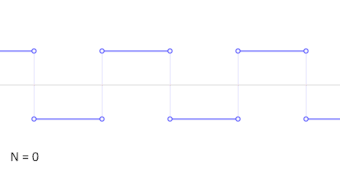
An animation of the additive synthesis of a square wave with an increasing number of harmonics
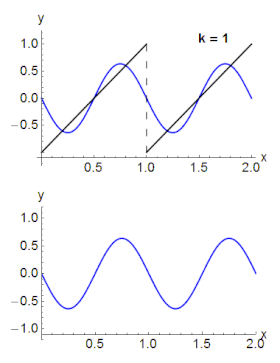
Sinusoidal basis functions (bottom) can form a sawtooth wave (top) when added. All the basis functions have nodes at the nodes of the sawtooth, and all but the fundamental (k = 1) have additional nodes. The oscillation seen about the sawtooth when k is large is called the Gibbs phenomenon
The trigonometric functions are also important in physics. The sine and the cosine functions, for example, are used to describe simple harmonic motion, which models many natural phenomena, such as the movement of a mass attached to a spring and, for small angles, the pendular motion of a mass hanging by a string. The sine and cosine functions are one-dimensional projections of uniform circular motion.
Trigonometric functions also prove to be useful in the study of general periodic functions. The characteristic wave patterns of periodic functions are useful for modeling recurring phenomena such as sound or light waves.[23]
Under rather general conditions, a periodic function f(x) can be expressed as a sum of sine waves or cosine waves in a Fourier series.[24] Denoting the sine or cosine basis functions by φk, the expansion of the periodic function f(t) takes the form:
- f(t)=∑k=1∞ckφk(t).{displaystyle f(t)=sum _{k=1}^{infty }c_{k}varphi _{k}(t).}
For example, the square wave can be written as the Fourier series
- fsquare(t)=4π∑k=1∞sin((2k−1)t)2k−1.{displaystyle f_{text{square}}(t)={frac {4}{pi }}sum _{k=1}^{infty }{sin {big (}(2k-1)t{big )} over 2k-1}.}
In the animation of a square wave at top right it can be seen that just a few terms already produce a fairly good approximation. The superposition of several terms in the expansion of a sawtooth wave are shown underneath.
History
While the early study of trigonometry can be traced to antiquity, the trigonometric functions as they are in use today were developed in the medieval period. The chord function was discovered by Hipparchus of Nicaea (180–125 BCE) and Ptolemy of Roman Egypt (90–165 CE).
The functions sine and cosine can be traced to the jyā and koti-jyā functions used in Gupta period Indian astronomy (Aryabhatiya, Surya Siddhanta), via translation from Sanskrit to Arabic and then from Arabic to Latin.[25]
All six trigonometric functions in current use were known in Islamic mathematics by the 9th century, as was the law of sines, used in solving triangles.[26]al-Khwārizmī produced tables of sines, cosines and tangents.
They were studied by authors including Omar Khayyám, Bhāskara II, Nasir al-Din al-Tusi, Jamshīd al-Kāshī (14th century), Ulugh Beg (14th century), Regiomontanus (1464), Rheticus, and Rheticus' student Valentinus Otho.
Madhava of Sangamagrama (c. 1400) made early strides in the analysis of trigonometric functions in terms of infinite series.[27]
The terms tangent and secant were first introduced by the Danish mathematician Thomas Fincke in his book Geometria rotundi (1583).[28]
The first published use of the abbreviations sin, cos, and tan is probably by the 16th century French mathematician Albert Girard.[citation needed]
In a paper published in 1682, Leibniz proved that sin x is not an algebraic function of x.[29]
Leonhard Euler's Introductio in analysin infinitorum (1748) was mostly responsible for establishing the analytic treatment of trigonometric functions in Europe, also defining them as infinite series and presenting "Euler's formula", as well as near-modern abbreviations (sin., cos., tang., cot., sec., and cosec.).[25]
A few functions were common historically, but are now seldom used, such as the chord (crd(θ) = 2 sin(θ/2)), the versine (versin(θ) = 1 − cos(θ) = 2 sin2(θ/2)) (which appeared in the earliest tables[25]), the coversine (coversin(θ) = 1 − sin(θ) = versin(π/2-θ)), the haversine (haversin(θ) = 1/2versin(θ) = sin2(θ/2)),[30] the exsecant (exsec(θ) = sec(θ) − 1), and the excosecant (excsc(θ) = exsec(π/2 − θ) = csc(θ) − 1). See List of trigonometric identities for more relations between these functions.
Etymology
The word sine derives[31] from Latin sinus, meaning "bend; bay", and more specifically "the hanging fold of the upper part of a toga", "the bosom of a garment", which was chosen as the translation of what was interpreted as the Arabic word jaib, meaning "pocket" or "fold" in the twelfth-century translations of works by Al-Battani and al-Khwārizmī into Medieval Latin.[32]
The choice was based on a misreading of the Arabic written form j-y-b (جيب), which itself originated as a transliteration from Sanskrit jīvā, which along with its synonym jyā (the standard Sanskrit term for the sine) translates to "bowstring", being in turn adopted from Ancient Greek χορδή "string".[33]
The word tangent comes from Latin tangens meaning "touching", since the line touches the circle of unit radius, whereas secant stems from Latin secans—"cutting"—since the line cuts the circle.[34]
The prefix "co-" (in "cosine", "cotangent", "cosecant") is found in Edmund Gunter's Canon triangulorum (1620), which defines the cosinus as an abbreviation for the sinus complementi (sine of the complementary angle) and proceeds to define the cotangens similarly.[35][36]
See also
All Students Take Calculus — a mnemonic for recalling the signs of trigonometric functions in a particular quadrant of a Cartesian plane- Aryabhata's sine table
- Bhaskara I's sine approximation formula
- Generalized trigonometry
- Generating trigonometric tables
- Hyperbolic function
- List of periodic functions
- List of trigonometric identities
- Madhava series
- Madhava's sine table
Polar sine — a generalization to vertex angles- Proofs of trigonometric identities
Versine — for several less used trigonometric functions
Notes
^ Klein, Christian Felix (1924) [1902]. Elementarmathematik vom höheren Standpunkt aus: Arithmetik, Algebra, Analysis (in German). 1 (3rd ed.). Berlin: J. Springer..mw-parser-output cite.citation{font-style:inherit}.mw-parser-output .citation q{quotes:"""""""'""'"}.mw-parser-output .citation .cs1-lock-free a{background:url("//upload.wikimedia.org/wikipedia/commons/thumb/6/65/Lock-green.svg/9px-Lock-green.svg.png")no-repeat;background-position:right .1em center}.mw-parser-output .citation .cs1-lock-limited a,.mw-parser-output .citation .cs1-lock-registration a{background:url("//upload.wikimedia.org/wikipedia/commons/thumb/d/d6/Lock-gray-alt-2.svg/9px-Lock-gray-alt-2.svg.png")no-repeat;background-position:right .1em center}.mw-parser-output .citation .cs1-lock-subscription a{background:url("//upload.wikimedia.org/wikipedia/commons/thumb/a/aa/Lock-red-alt-2.svg/9px-Lock-red-alt-2.svg.png")no-repeat;background-position:right .1em center}.mw-parser-output .cs1-subscription,.mw-parser-output .cs1-registration{color:#555}.mw-parser-output .cs1-subscription span,.mw-parser-output .cs1-registration span{border-bottom:1px dotted;cursor:help}.mw-parser-output .cs1-ws-icon a{background:url("//upload.wikimedia.org/wikipedia/commons/thumb/4/4c/Wikisource-logo.svg/12px-Wikisource-logo.svg.png")no-repeat;background-position:right .1em center}.mw-parser-output code.cs1-code{color:inherit;background:inherit;border:inherit;padding:inherit}.mw-parser-output .cs1-hidden-error{display:none;font-size:100%}.mw-parser-output .cs1-visible-error{font-size:100%}.mw-parser-output .cs1-maint{display:none;color:#33aa33;margin-left:0.3em}.mw-parser-output .cs1-subscription,.mw-parser-output .cs1-registration,.mw-parser-output .cs1-format{font-size:95%}.mw-parser-output .cs1-kern-left,.mw-parser-output .cs1-kern-wl-left{padding-left:0.2em}.mw-parser-output .cs1-kern-right,.mw-parser-output .cs1-kern-wl-right{padding-right:0.2em}
^ Klein, Christian Felix (2004) [1932]. Elementary Mathematics from an Advanced Standpoint: Arithmetic, Algebra, Analysis. Translated by Hedrick, E. R.; Noble, C. A. (Translation of 3rd German ed.). Dover Publications, Inc. / The Macmillan Company. ISBN 978-0-48643480-3. Archived from the original on 2018-02-15. Retrieved 2017-08-13.
^ Oxford English Dictionary, sine, n.2
^ Oxford English Dictionary, cosine, n.
^ Oxford English Dictionary, tangent, adj. and n.
^ Oxford English Dictionary, secant, adj. and n.
^ Heng, Cheng and Talbert, "Additional Mathematics" Archived 2015-03-20 at the Wayback Machine, page 228
^ Bityutskov, V.I. (2011-02-07). "Trigonometric Functions". Encyclopedia of Mathematics. Archived from the original on 2017-12-29. Retrieved 2017-12-29.
^ Larson, Ron (2013). Trigonometry (9th ed.). Cengage Learning. p. 153. ISBN 978-1-285-60718-4. Archived from the original on 2018-02-15.
Extract of page 153 Archived 2018-02-15 at the Wayback Machine
^ See Ahlfors, pages 43–44.
^ Abramowitz; Weisstein.
^ Stanley, Enumerative Combinatorics, Vol I., page 149
^ Aigner, Martin; Ziegler, Günter M. (2000). Proofs from THE BOOK (Second ed.). Springer-Verlag. p. 149. ISBN 978-3-642-00855-9. Archived from the original on 2014-03-08.
^ Remmert, Reinhold (1991). Theory of complex functions. Springer. p. 327. ISBN 978-0-387-97195-7. Archived from the original on 2015-03-20.
Extract of page 327 Archived 2015-03-20 at the Wayback Machine
^ For a demonstration, see Euler's formula#Using power series
^ Needham, Tristan (1998). Visual Complex Analysis. ISBN 978-0-19-853446-4.
^ Kannappan, Palaniappan (2009). Functional Equations and Inequalities with Applications. Springer. ISBN 978-0387894911.
^ Kantabutra.
^ However, doing that while maintaining precision is nontrivial, and methods like Gal's accurate tables, Cody and Waite reduction, and Payne and Hanek reduction algorithms can be used.
^ Brent, Richard P. (April 1976). "Fast Multiple-Precision Evaluation of Elementary Functions". J. ACM. 23 (2): 242–251. doi:10.1145/321941.321944. ISSN 0004-5411.
^ Abramowitz, Milton and Irene A. Stegun, p.74
^ ab The Universal Encyclopaedia of Mathematics, Pan Reference Books, 1976, page 529-530. English version George Allen and Unwin, 1964. Translated from the German version Meyers Rechenduden, 1960.
^ Farlow, Stanley J. (1993). Partial differential equations for scientists and engineers (Reprint of Wiley 1982 ed.). Courier Dover Publications. p. 82. ISBN 978-0-486-67620-3. Archived from the original on 2015-03-20.
^ See for example, Folland, Gerald B. (2009). "Convergence and completeness". Fourier Analysis and its Applications (Reprint of Wadsworth & Brooks/Cole 1992 ed.). American Mathematical Society. pp. 77ff. ISBN 978-0-8218-4790-9. Archived from the original on 2015-03-19.
^ abc Boyer, Carl B. (1991). A History of Mathematics (Second ed.). John Wiley & Sons, Inc.
ISBN 0-471-54397-7, p. 210.
^ Gingerich, Owen (1986). "Islamic Astronomy". 254. Scientific American: 74. Archived from the original on 2013-10-19. Retrieved 2010-07-13.
^ O'Connor, J. J.; Robertson, E. F. "Madhava of Sangamagrama". School of Mathematics and Statistics University of St Andrews, Scotland. Archived from the original on 2006-05-14. Retrieved 2007-09-08.
^ "Fincke biography". Archived from the original on 2017-01-07. Retrieved 2017-03-15.
^ Bourbaki, Nicolás (1994). Elements of the History of Mathematics. Springer.
^ Nielsen (1966, pp. xxiii–xxiv)
^ The anglicized form is first recorded in 1593 in Thomas Fale's Horologiographia, the Art of Dialling.
^ Various sources credit the first use of sinus to either
Plato Tiburtinus's 1116 translation of the Astronomy of Al-Battani
Gerard of Cremona's translation of the Algebra of al-Khwārizmī
Robert of Chester's 1145 translation of the tables of al-Khwārizmī
See Merlet, A Note on the History of the Trigonometric Functions in Ceccarelli (ed.), International Symposium on History of Machines and Mechanisms, Springer, 2004
See Maor (1998), chapter 3, for an earlier etymology crediting Gerard.
See Katx, Victor (July 2008). A history of mathematics (3rd ed.). Boston: Pearson. p. 210 (sidebar). ISBN 978-0321387004.
^ See Plofker, Mathematics in India, Princeton University Press, 2009, p. 257
See "Clark University". Archived from the original on 2008-06-15.
See Maor (1998), chapter 3, regarding the etymology.
^ Oxford English Dictionary
^ Gunter, Edmund (1620). Canon triangulorum.
^ Roegel, Denis, ed. (2010-12-06). "A reconstruction of Gunter's Canon triangulorum (1620)" (Research report). HAL. inria-00543938. Archived from the original on 2017-07-28. Retrieved 2017-07-28.
References
.mw-parser-output .refbegin{font-size:90%;margin-bottom:0.5em}.mw-parser-output .refbegin-hanging-indents>ul{list-style-type:none;margin-left:0}.mw-parser-output .refbegin-hanging-indents>ul>li,.mw-parser-output .refbegin-hanging-indents>dl>dd{margin-left:0;padding-left:3.2em;text-indent:-3.2em;list-style:none}.mw-parser-output .refbegin-100{font-size:100%}
Abramowitz, Milton; Stegun, Irene Ann, eds. (1983) [June 1964]. Handbook of Mathematical Functions with Formulas, Graphs, and Mathematical Tables. Applied Mathematics Series. 55 (Ninth reprint with additional corrections of tenth original printing with corrections (December 1972); first ed.). Washington D.C.; New York: United States Department of Commerce, National Bureau of Standards; Dover Publications. ISBN 978-0-486-61272-0. LCCN 64-60036. MR 0167642. LCCN 65-12253.
Lars Ahlfors, Complex Analysis: an introduction to the theory of analytic functions of one complex variable, second edition, McGraw-Hill Book Company, New York, 1966.
Boyer, Carl B., A History of Mathematics, John Wiley & Sons, Inc., 2nd edition. (1991).
ISBN 0-471-54397-7.- Gal, Shmuel and Bachelis, Boris. An accurate elementary mathematical library for the IEEE floating point standard, ACM Transactions on Mathematical Software (1991).
- Joseph, George G., The Crest of the Peacock: Non-European Roots of Mathematics, 2nd ed. Penguin Books, London. (2000).
ISBN 0-691-00659-8. - Kantabutra, Vitit, "On hardware for computing exponential and trigonometric functions," IEEE Trans. Computers 45 (3), 328–339 (1996).
- Maor, Eli, Trigonometric Delights, Princeton Univ. Press. (1998). Reprint edition (February 25, 2002):
ISBN 0-691-09541-8.[dead link]
- Needham, Tristan, "Preface"" to Visual Complex Analysis. Oxford University Press, (1999).
ISBN 0-19-853446-9.
Nielsen, Kaj L. (1966), Logarithmic and Trigonometric Tables to Five Places (2nd ed.), New York, USA: Barnes & Noble, LCCN 61-9103
- O'Connor, J. J., and E. F. Robertson, "Trigonometric functions", MacTutor History of Mathematics archive. (1996).
- O'Connor, J. J., and E. F. Robertson, "Madhava of Sangamagramma", MacTutor History of Mathematics archive. (2000).
- Pearce, Ian G., "Madhava of Sangamagramma", MacTutor History of Mathematics archive. (2002).
- Weisstein, Eric W., "Tangent" from MathWorld, accessed 21 January 2006.
External links
| Wikibooks has a book on the topic of: Trigonometry |
Hazewinkel, Michiel, ed. (2001) [1994], "Trigonometric functions", Encyclopedia of Mathematics, Springer Science+Business Media B.V. / Kluwer Academic Publishers, ISBN 978-1-55608-010-4
- Visionlearning Module on Wave Mathematics
GonioLab Visualization of the unit circle, trigonometric and hyperbolic functions
q-Sine Article about the q-analog of sin at MathWorld
q-Cosine Article about the q-analog of cos at MathWorld

























![{displaystyle sin 1^{circ }={frac {{sqrt[{3}]{z}}-{dfrac {1}{sqrt[{3}]{z}}}}{2i}},}](https://wikimedia.org/api/rest_v1/media/math/render/svg/da4d43029e6c6c7f6e94ab404965fbf5880101c9)


















































